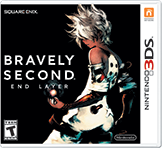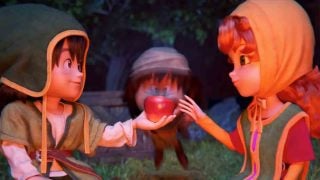Disclaimer: This is a review of a European copy of Bravely Second, which was released February 26th, 2016.
Back when Bravely Default launched for the 3DS it was something of a revelation. Turn-based JRPGs weren’t nearly as massively popular as they once were, and fewer and fewer were being developed, especially from the traditional JRPG titan that once was Square-Enix.
To bring the genre back to the forefront, Bravely Default cleverly tweaked mechanics and featured a very unique take on the classic Final Fantasy formula, and ultimately made it clear that turn based JRPGs still had a place in modern video gaming. With its positive reception and popularity in the East and West, it’s only natural a sequel was greenlit. The question is: Does Bravely Second improve on its predecessor in any meaningful way?
Penning a new journal
Just after the release of Bravely Default in North America, game director Tomoyo Asano told fans that the structure of the game was inspired by American television shows, bizarrely citing Beverly Hills 90210 and Glee as examples. He explained that characters would be introduced through levity, and then drama would take shape later on.
At the time, I couldn’t see the connection; Bravely Default was divided into somewhat episodic chapters, and definitely had its funny moments, but it felt aggressively dark right from the beginning, where a humble town is obliterated by a blinding light.
Bravely Second, on the other hand, definitely feels influenced by the realm of television. Almost every chapter opens with a slick CGI opening, complete with a peppy J-pop song; the story dips into countless different genres, and there are more recurring characters and clear-cut conflicts than before.

That isn’t to say the game is totally immune to cliches though. There are romantic misunderstandings, a clumsy duo of recurring villains akin to Team Rocket, and one extended sequence featuring hijinks at a hot spring. That’s not to mention the ridiculous amount of puns peppered throughout the game, some of which made me roll my eyes so hard I think I strained them. Whether this tone works for you is entirely subjective, but personally I think it hits more than it misses.

Unfortunately, one aspect of the game that hasn’t improved is the voiceover quality, which can sound incredibly compressed at times. While it’s not a major issue for most characters, some get it worse than others, especially a certain cowgirl with a Southern drawl. These RPGs are undeniably huge in the dialogue department, and while the support for both English and Japanese voiceovers is commendable I can’t help but wonder if it came at the cost of overall audio quality.
The music in Bravely Second is a mix of returning tracks and brand new jams, the latter of which were composed by Ryo of the J-pop music group Supercell. While it’s unfortunate the first game’s composers, Revo, couldn’t make a return with another stellar soundtrack, the new songs are in-keeping with their tone and there are some definite stand outs.
Exploring Luxendarc
Naturally, as the game is set a mere two years after the events of the first game, very little has changed in the way of geography. The continents are almost identical, iconic locations return, and even many of the dungeons you toiled through several times already make a comeback. While these visits can lead to some interesting moments, such as finding out what the residents of the sand city Ancheim are doing after their corrupt King was deposed, very little of this is reflected visually.

There are plenty of new locales to visit as well, with breathtaking painted backdrops and unique dungeon mechanics. These areas are almost-seamlessly placed where empty space existed in the first game, and thankfully you tend to spend more time in them than in familiar places.

Moral choices
One of the biggest changes to progression in Bravely Second is how it handles side missions. These diversions focus on the challenges faced by Edea, who, as a high ranking member of the Eternian duchy, has to help or hinder the members of her army in their post-war ventures.
This is where a lot of the thematic genre switching comes into play; one side mission you’ll be helping figure out the future of a state’s education, the next you’ll be deciding who takes priority in a survival situation. This ultimately comes down to a binary choice, and you’ll end up fighting whoever’s plans you stand against.

Getting a Job
As the returning Jobs are fenced behind those moral dilemmas, Bravely Second has to account for players not getting access to fundamental abilities. To do this the game introduces a number of new asterisks that help cover the basics, but with twists. For example, the Wizard job may seem like Black Mage on the surface, but its unique Spellcasting ability is a game changer. With it you can apply various effects to your spells, such as making them always hit first, strongly affect identical foes, or even inflict damage over several turns with elemental mists.


Conclusion
Western players of Bravely Default may not know that its groundbreaking accessibility options, such as the encounter rate slider, battle fast forwarding, and the Bravely Second mechanic itself, weren’t in the original Japanese release. The version of the game localized was in fact an updated re-release, subtitled “For the Sequel” in Japan.
I bring this up because, as a result of this retroactive inclusion, there are very few innovations to be found in Bravely Second. While there are some new features, like the bizarre cookie clicker-esque Chompcraft, there’s nothing quite as significant as what came before.
When these returning mechanics are so well crafted, however, it’s hard to view this lack of innovation as a deal breaker. Fans who loved their time with the first game will have just as much fun with the sequel, and should definitely make the return to Luxendarc as soon as possible to experiment with the new jobs and abilities.
Newcomers may best be served going back and experiencing this saga from the beginning. While the first game is quickly summarized in the opening cutscene of Bravely Second, the franchise prides itself on fleshed out characters and a subtle deep mythology that’s peppered throughout both games. The massive number of Jobs could be overwhelming for the uninitiated as well, despite the game’s attempts to pace them through the aforementioned side missions.
Whichever camp you fall into, Bravely Second is a fantastic traditional-yet-subversive JRPG that should be experienced by any fan of the genre.
Pre-order Bravely Second: End Layer on Amazon today and receive the Al-Khampis Costume Set DLC as a bonus gift!

System: Nintendo 3DS
Release date: April 15, 2016
Category: Role-playing game
Publisher: Nintendo
Developer: Square Enix

